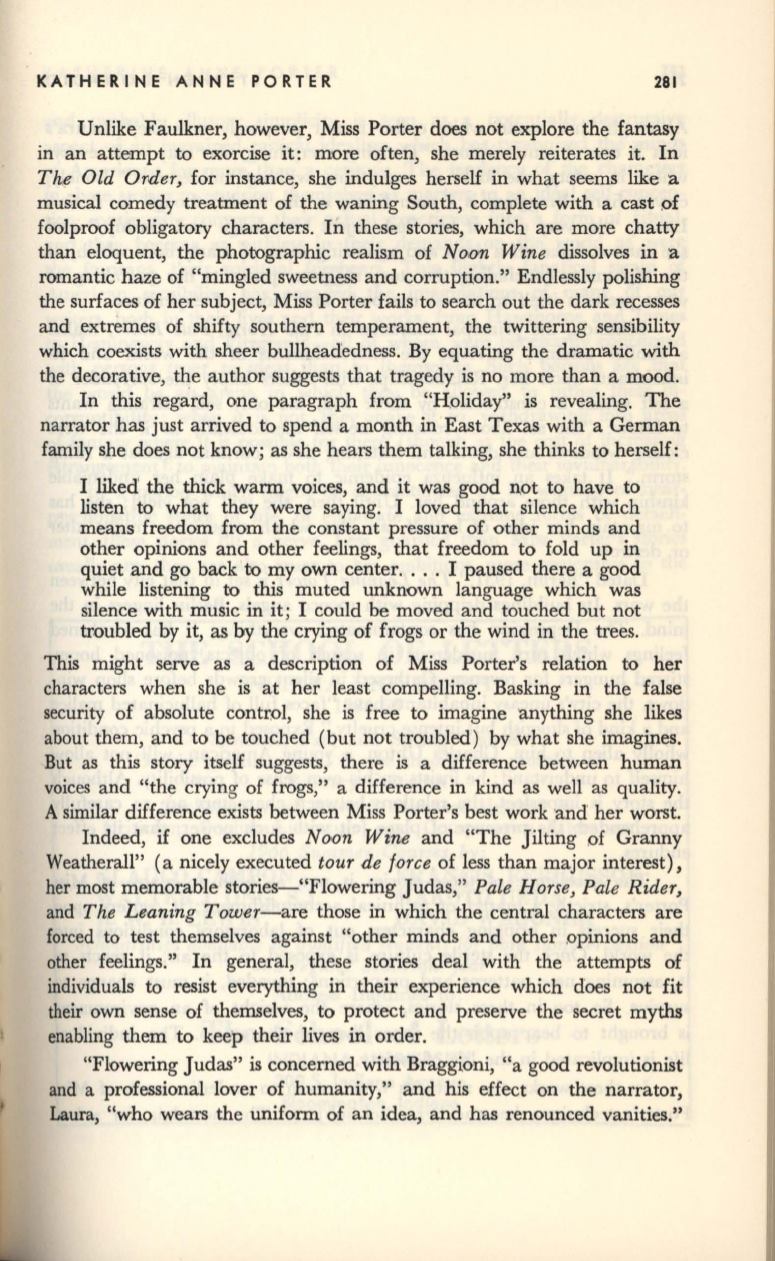
KATHERINE ANNE PORTER
281
Unlike Faulkner, however, Miss Porter does not explore the fantasy
in an attempt
to
exorcise it: more often, she merely reiterates it.
In
The Old Order,
for instance, she indulges herself in what seems like a
musical comedy treatment of the waning South, complete with a cast of
foolproof obligatory characters.
In
these stories, which are more chatty
than eloquent, the photographic realism of
Noon Wine
dissolves
in
a
romantic haze of "mingled sweetness and corruption." Endlessly polishing
the surfaces of her subject, Miss Porter fails to search out the dark recesses
and extremes of shifty southern temperament, the twittering sensibility
which coexists with sheer bullheadedness. By equating the dramatic with
the decorative, the author suggests that tragedy is no more than a mood.
In
this
reg~rd,
one paragraph from "Roliday" is revealing. The
narrator has just arrived to spend a month in East Texas with a German
family she does not know; as she hears them talking, she thinks to herself:
I liked the thick warm voices, and it was good not to have to
listen to what they were saying. I loved that silence which
means freedom from the constant pressure of other minds and
other opinions and other feelings, that freedom to fold up in
quiet and go back to my own center.... I paused there a good
while listening to this muted unknown language which was
silence with music in it; I could
be
moved and touched but not
troubled by it, as by the crying of frogs or the wind in the trees.
This
might serve as a description of Miss Porter's relation to her
characters when she is at her least compelling. Basking in the false
security of absolute control, she is free to imagine anything she likes
about them, and to be touched (but not troubled) by what she imagines.
But as this story itself suggests, there is a difference between human
voices and "the crying of frogs," a difference in kind as well as quality.
A similar difference exists between Miss Porter's best work and her worst.
Indeed, if one excludes
Noon Wine
and "The Jilting of Granny
Weatherall" (a nicely executed
tour de force
of less than major interest),
her most memorable stories-"Flowering Judas,"
Pale Horse, Pale Rider,
and
The Leaning Tower-are
those in which the central characters are
forced to test themselves against "other minds and other opinions and
other feelings." In general, these stories deal with the attempts of
individuals
to
resist everything in their experience which does not fit
their own sense of themselves, to protect and preserve the secret myths
enabling them to keep their lives in order.
"Flowering Judas" is concerned with Braggioni, "a good revolutionist
and a professional lover of humanity," and
his
effect on the narrator,
Laura, "who wears the uniform of an idea, and has renounced vanities."


